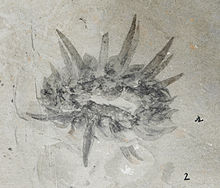Wiwaxia
|
Wiwaxia Temporal range: Cambrian, 520–505 Ma |
|
|---|---|
 |
|
| Reconstruction Wiwaxia corrugata | |
 |
|
| Fossil showing underside of Wiwaxia corrugata from the Burgess Shale. From Smith (2014). | |
| Scientific classification | |
| Kingdom: | Animalia |
| Superphylum: | Lophotrochozoa |
| Phylum: | Mollusca (?) |
| Family: |
†Wiwaxiidae Walcott, 1911 |
| Genus: |
†Wiwaxia Walcott, 1911 |
| Species | |
|
|
Wiwaxia is a genus of soft-bodied animals that were covered in carbonaceous scales and spines. Wiwaxia fossils – mainly isolated scales, but sometimes complete, articulated fossils – are known from early Cambrian and middle Cambrian fossil deposits across the globe. The living animal would have measured up to 5 cm (2 inch) when fully grown, although a range of juvenile specimens are known, the smallest being 2 millimetres (0.079 in) long.
Wiwaxia’s affinity has been a matter of debate: researchers were long split between two possibilities. On the one hand, its rows of scales looked superficially similar to certain scale worms (annelids); conversely, its mouthparts and general morphology suggested a relationship to the shell-less molluscs. More recently, evidence for a molluscan affinity has been accumulating, based on new details of Wiwaxia’s mouthparts, scales, and growth history.
The proposed clade Halwaxiida contains Wiwaxia as well as several similar Cambrian animals.
This article probably concentrates on the species Wiwaxia corrugata, which is known from hundreds of complete specimens in the Burgess Shale; other species are known only from fragmentary material or limited sample sizes.
Wiwaxia was bilaterally symmetrical; viewed from the top the body was elliptical with no distinct head or tail, and from the front or rear it was almost rectangular. It reached 5 centimetres (2.0 in) in length. Estimating their height is difficult because specimens were compressed after death; a typical specimen may have been 1 centimetre (0.39 in) high excluding the spines on their backs. The ratio of width to length does not appear to change as the animals grew.
Wiwaxia’s flat underside was soft and unarmored; most of the surface was occupied by a slug-like foot. Little is known of the internal anatomy, although the gut apparently ran straight and all the way from the front to the rear. At the front end of the gut, about 5 millimetres (0.20 in) from the animal's front in an average specimen about 2.5 centimetres (0.98 in) long, there was a feeding apparatus that consisted of two (or in rare large specimens three) rows of backward-pointing conical teeth. The feeding apparatus was tough enough to be frequently preserved, but unmineralized and fairly flexible.
...
Wikipedia
